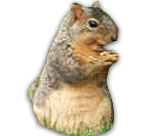Squirrels
Red: Tamiasciurus hudsonicus
|
General Characteristics: - Dorsal surface ranges from grizzled dark to pale grey and may have cinnamon tones - The ears are pale grey to white and its tail is white to pale grey - Underparts are grey to buff - Total length of these squirrels ranges from 380 to 525 mm - Tail length ranges from 150 to 250 mm, ear length ranges from 25 to 33mm, and hind foot length ranges from 54 to 76mm Red Squirrel - Red squirrels have a total body length of from 280 to 350 mm, with the tail making up from 95 to 150 mm of that - During the summer, a black stripe runs along their side, between the fur color of their back and their belly - The belly is white or cream color. The tail is often edged with white - There are white bands encircling their large, black eyes - Adapted for climbing and running through the trees with compact, muscled bodies, strong claws, and powerful hind limbs Reproduction: - Breeding occurs in December-February and May-June and is slightly delayed in more northern latitudes. - Gestation lasts 44 days. - Females may bear young twice a year for more than 8 years. - Males usually are sexually mature by 11 months
Signs of Infestation: - Establish themselves around in attics, garages to store food and find shelter - Often gnaw on the exterior and interior walls and timbers, on cables and electrical wiring - Signs of damage to trees and gardens are also a sign on infestation - Feeding off nuts, seeds, buds, leaves, bulbs, bark, insects and fruit
Control Techniques: - Live trapping/removal the squirrels may be necessary. Consult with local MNR offices. - Live-trapped squirrels may be humanely destroyed if legal, or taken at least 1km from the trap site and released in an area where they will not cause a problem for someone else. - 'One-way doors' may be used to allow squirrel to leave structures, but not return. Benett, Gary W., et.al.. Truman’s Scientific Guide to Pest Control Operations. Duluth: Advanstar Communications, 1988. p.366-367. Lawniczak, M. 2002. "Sciurus carolinensis" (On-line), Animal Diversity Web. Accessed January 13, 2010 at http://animaldiversity.ummz.umich.edu/site/accounts/information/Sciurus_carolinensis.html.
|


